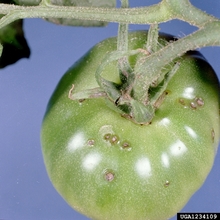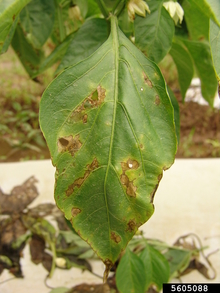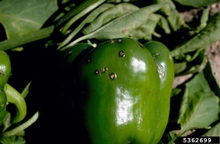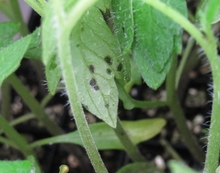Quick facts
- Bacterial spot can be a devastating disease when the weather is warm and humid.
- Four closely related bacteria cause bacterial spot: Xanthomonas vesicatoria, X. euvesicatoria, X. gardneri, and X. perforans.
- The disease can affect all above-ground parts of tomato and pepper plants: stems, petioles, leaves, and fruits.
- Fruit spots commonly result in unmarketable fruit.
How to tell bacterial spot apart from other issues
- When it first appears on the leaves, bacterial spot is similar in appearance to many other tomatoes diseases
- Tomato leaves have small (less than 1/8 inch), brown, circular spots surrounded by a yellow halo.
- The center of the leaf spots often falls out resulting in small holes.
- The leaf spots do not contain concentric rings, spots with concentric rings are likely caused by early blight.
- Pepper leaves have small (less than 1/8 inch), brown, circular spots that do not have a yellow halo and centers do not fall out.
- Small, brown, circular spots may also occur on stems and the fruit calyx.
- Fruit spots are 1/4 inch, slightly raised, brown and scabby.
- Tomato fruit often have a waxy white halo surrounding the fruit spot.
- Pepper fruit spots often occur on the stem-end of the fruit.
- Spots occur on green and red fruit but do not result in rot.
Biology
- Four closely related bacteria cause bacterial spot: Xanthomonas vesicatoria, X. euvesicatoria, X. gardneri, and X. perforans.
- Different strains infect either tomato or pepper or both.
- All strains prefer high temperatures (75°F to 86°F), high humidity, and frequent rainfall/overhead irrigation.
- Bacteria survive on plant debris in the soil for one to two years, but will not survive once plant debris breaks down.
- Introduction is primarily on infected seed or infected transplants. Even seedlings that do not show symptoms may be infected and will show symptoms later in the growing season.
- Bacteria can spread from plant to plant by tools, growers’ hands, or through splashing rain or irrigation water.
- Between rotations, the bacteria may survive on tomato or pepper volunteer plants.
Managing bacterial spot in home gardens
- Look for leaves with spots, especially during periods of wet, humid weather.
- Remove leaves with symptoms.
- There are many varieties of bell pepper and hot pepper with resistance to bacterial spot.
- A few tomato varieties with resistance are available.
- For a full list of varieties, see the Cornell University Disease Resistant Vegetable Varieties page.
- Plant tomatoes where no tomatoes, potatoes, peppers or eggplants have been for the past 3-4 years.
- If starting your own seeds, choose seeds from a reputable supplier.
- If saving seeds, use a hot water treatment.
- If buying transplants, inspect transplants and choose plants without spots or discoloration
- Keep tomato leaves as dry as possible. Water with drip irrigation or a soaker hose. If watering by hand, do so at the base of the plant.
- Water in the morning so leaves dry quickly in the sun.
- Space plants so that air flows between them. This could range from 18-24 inches for caged tomatoes to 30-36 inches for uncaged determinate tomatoes.
- Stake or cage plants.
- Remove or bury plants at the end of the season.
- Spots on fruit can allow secondary pathogens to enter fruit, some of which can make people sick.
- It is best to not eat fruit with bacterial spot.
Managing bacterial spot on farms
Scout transplants carefully. Symptoms on transplants can look different from the bacterial disease symptoms you may be familiar with in the field.
Look for:
- Dark black or brown spots with a yellow halo
- Tan spots
- Blotchy areas on steams and/or leaves
In both the greenhouse and the field, early symptoms will be most apparent during times when leaves are wet.
- Varieties with resistance to bacterial spot are available.
- There are many varieties of bell pepper and hot pepper with resistance to bacterial spot.
- A few tomato varieties with resistance are available.
Before planting and during transplant production
- Purchase high quality, certified disease-free seed if possible.
- Hot water treatment can be used to kill bacteria on and in seed.
- For growers producing their own seedlings, avoid over-watering and handle plants as little as possible. Disinfect greenhouses, tools, and equipment between seedling crops with a commercial sanitizer.
- For growers purchasing transplants, buy plants from reputable growers who start with clean seed and use good cultural practices to reduce disease.
- Space plants adequately. Space tomato plants 14-16 inches apart for single leader high tunnel tomatoes that are heavily pruned. Space plants 18-24 inches if tomatoes are grown in cages or pruned less intensively.
In the field
- Once plants are in the field, avoid overhead watering.
- Do not work in plants when wet to avoid spreading disease.
- Avoid high-pressure sprays, as these may injure leaves enough to encourage the introduction of the bacterial pathogen.
- Disinfect pruners and other tools by dipping in a commercial sanitizer, or a 1:9 dilution of germicidal bleach. To be efficient when pruning, have two pruners and alternate between plants to allow proper soaking time. For more information about disinfecting tools, see the University of Minnesota’s Clean and Disinfecting Gardening Tools and Containers.
- Bury or remove crop debris at the end of the season.
- Rotate away from tomato or pepper for a year.
- Control tomato or pepper volunteers during rotations to other crops.
During transplant production, weeding out transplants with bacterial spot symptoms is key in season-long control, as plants cannot be cured of bacterial spot.
In tomatoes, research in Florida on bacterial spot has shown that overhead watering allows bacterial spot to move throughout transplant production trays.
- In the study, one tray of tomato transplants was inoculated with bacterial spot and placed in a transplant production greenhouse.
- Within 5 days, the bacteria had moved anywhere from 4 to 11 inches beyond the initial point of infection.
- After 12 days, the bacteria could be found five to ten feet away.
- The plants the bacteria were detected on didn’t necessarily show any symptoms of infection yet, with a 5-7 day lag between infection and symptoms appearing.
- Pesticide options are limited for bacterial diseases.
- Resistance to copper is well-documented in bacterial spot.
- For tomatoes, streptomycin is labeled for greenhouse use.
- In the field, applications should be made when environmental conditions favor disease to be the most effective and repeated according to label instructions.
- For a current list of pesticides for bacterial spot management visit the Midwest Vegetable Production Guide.
CAUTION: Mention of a pesticide or use of a pesticide label is for educational purposes only. Always follow the pesticide label directions attached to the pesticide container you are using. Be sure that the plant you wish to treat is listed on the label of the pesticide you intend to use. And observe the number of days between pesticide application and when you can harvest your crop. Remember, the label is the law.
Reviewed in 2021






